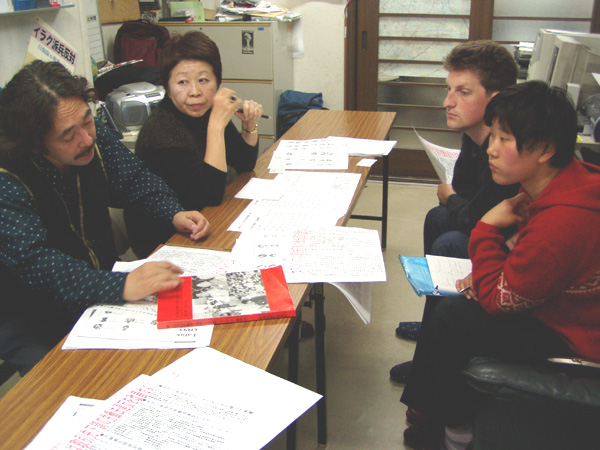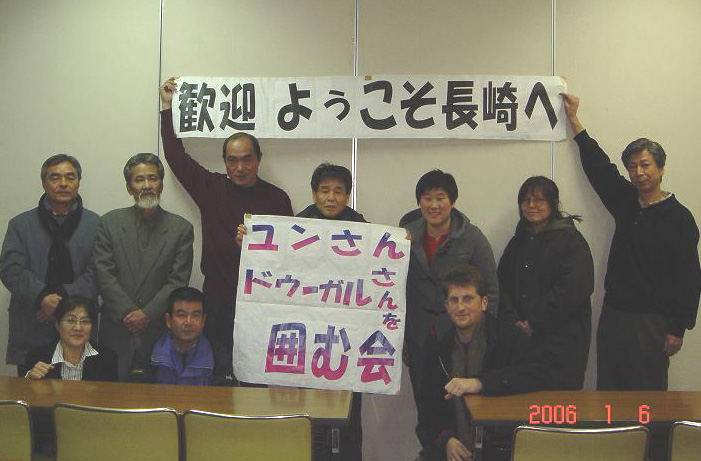Feelings of solidarity from an Australian socialist
Shomi Yoon
My name is Shomi Yoon and I am a currently studying translation and interpretation at MonashUniversity in Australia.My other main activity is being involved in a socialist organization called Socialist Alternative (www.sa.org.au).Last year I participated in Australiafs biggest workerfs demonstration in history.The class antagonism, normally simmering below the surface, was at boiling point with more than 500 000 angry workers against the Howard Government.
It has been three years since I last visited Japan and it was the first time for my partner, Dougal McNeill, to come to Japan.Japan is Australiafs largest trading partner and as such enjoys relatively more media attention compared to other Asian nations.Issues such as the postal reforms, Japanfs Self Defence Force, the Yasukuni Shrine, and textbook problems, declining birth rate, whaling and NEETO are things that one hears time and time again.
Whilst the problems are reported in the mainstream media, never is the way workers respond to these problems reported.I contacted Manrico from Australia Asia Worker Links (AAWL) who lead me to Mr. Takahei from Asia Pacifc Workers Solidarity Link in the hope that I could find out and learn more about these struggles from below.
KanagawaCityUnion

On 17 December we visited the Kanagawa City Union (KCU), a suburb of Tokyo.I had never been to Kanagawa before.Prior the visit, Mr. Takahei had explained that Kangawa was a workerfs town.The union office atmosphere was so heated that not even lighting would have distracted the intense discussion that was taking place.It was a meeting on report backs from various unionists.Their passion and activity immediately came through to me.The thing that surprised me upon hearing their self-introductions was their different nationalities: Korean, Japanese-Brazilians, Japanese-Peruvians and of course, Japanese.I found out for the first time the extent that the Japanese government was using migrant labour to solve their economic crises.
The meeting broke for lunch.Luckily, or more accurately, magically we somehow ended up sitting next to a magician.He intrigued us with many magic tricks.I felt the keen sense of effort that KCU, a multicultural union, went to in order to communicate well with their equally multicultural members; perhaps not always verbally but always in feelings of solidarity.
After lunch KCUfs Chairman, Mr. Murayama, gave us a brief outline of the union.I immediately felt that the organizational structure of Japanese trade union was quite different to Australian (AUS) or New Zealand (NZ).In particular, I felt the concept of a gforeign workersh union strange.The economic development of both NZ and AUS has been such that it has historically always relied on migrant labour.Foreign workers committees are generally within the umbrella of a wider trade union.However, the growing membership of KCU indicates that is it orientating correctly to the changing Japanese society.
The highlight was sitting in on a union negotiation.It was our first time to see it first hand.Victory for KCU!
Ms. Tani from the Womenfs Trade Union Toky
On 19December we visited the Womenfs Trade Union Tokyo.I had a number of questions regarding the organizational aspects: Is it informed by radical feminism? What constitutes as being a gwomenh as women are divided by class and work circumstances?What happens in a workplace where there are both men and women?Women-specific unions are rare in AUS or NZ.
Ms Tani patiently explained my questions one by one.The comment that I found most interesting was the way the Womenfs Liberation Movement developed in Japan. Issues like domestic violence and sexual harassment were focused on more so at the birth of the movement than the Equal Pay issue. I will have to study more Japanese history to understand why events took place in the way it has, but the Womenfs Liberation Movement in AUS and NZ developed in a different way.One thing that is clear about the NZ and AUS situation is that it was the unions that took up the issue of Equal pay.It is these legacies that may have lead me to question the specific group focused union such as the KCU or the Womenfs union.
Ms. Shigematsu from Zentouitsu
We visited Ms. Shigematsu in the afternoon.There were similar issues to the KCU in terms of fighting for migrant workerfs rights.Japan is increasingly reliant on these migrant workers but they have no corresponding rights.The struggle needs to continue!
Mr. Nakashima from Yusei Union and the upcoming struggles
The postal reform that Koizumi is initiating has received considerable coverage in the mainstream media here as well.Because of this, I was extremely interested in the response of the postal workers. The postal reform has been an issue that has divided Japan; even avid supporters of the LDP feel uneasy about this.The question is how the postal workers can best fight back in this situation.Only a minority of workers are in the Yusei union so the fight against the reforms is a long one.
Twenty years ago, NZfs major state assets were similarly privatized.The experience of this has lead to deterioration in the conditions of workers.It is a similar experience again to the Rail workers in Japan.Undoubtedly it is the heroic actions of the rail workers who still continue to fight today that have maintained the working conditions Japan-wide.The fight against the privatization of the Post is a struggle worth waging and it has the legacy of the Railway workers to rely on.
 Celebrating gThe Weirdofsh birthday listening to Kobayashi Mariko live concert
Celebrating gThe Weirdofsh birthday listening to Kobayashi Mariko live concert
The Emperor was referred to as Hennou (Ïc)for the duration of the live concert
On 23 December I was invited by Mr. Nakashima to a live concert to hear Ms. Kobayashi; a woman who had been singing blues since the days of Womenfs Liberation Movement.
ôWhen I woke the next morning, his mind had changed.
I thought she would have man-hating lyrics and themes but far from it, her songs were about the struggles of women in a sexist society.Her songs of struggle brought about laughter and even tears from the crowd.
Nagasaki Peace Memorial
On the 7 January we visited the Nagasaki Peace Memorial.Professor Takazane was generous enough to guide us through.As I listened to his horrific explanations of what the Japanese military had done during WWII to the Koreans and Chinese, I felt a strange sense of rage combined with a desire to vomit.This feeling intensified when I learnt that the Peace Memorial received no governmental aid; the council would not even allow a street sign despite its location being right next to one of Nagasakifs major tourist attractions.Whilst the Japanese government has in words apologized for the war, it uses its atomic bomb victim hood status to refuse to take responsibility for the atrocities.It sent shivers up my spine thinking that I had blithely gone to Shinto Shrines, Japanfs state religion which they had forced upon the Koreans and Chinese.
NOTE: Nagasaki Peace Memorial is different to the more well-known Nagasaki Atomic Bomb Memorial
Mr. Yoshikawa from Zenkoku Ippan Nagasaki Rentai Union
That evening we got on a bus from Takara and headed out for Nagasakifs industrial heart, the Mitsubushi factories.I suddenly got a flashback of the horrific photos of all the forced Chinese and Korean labourers who vanished in the bomb as we reached the Akunoura bus stop.
I got the clearest picture of the trade union situation in Japan from talking to the Mitsubishi workers.My puzzles over the fractured unions were in part answered becauseAthey explained, of the yellow company unions that exist in Japan.Yellow unions do not exist in AUS.In response to these yellow unions, the left in Japan have historically split.The problem being, that these split unions only account for a tiny minority of workers.Thus the workplace struggles are muted because the workers are fractured.These splits are going to be an issue that the unions must overcome in the coming years.
After word
I would like to thank all the unions that helped make this trip a memorable and inspiring one.In particular I would like to thank Mr. Takahei (APWSL) for his networking and support to make this trip possible in the first place.I would also like to extend my thanks to Mr. Nakashima (Yusei Union Nagasaki) for being such a generous host and linking me up to the other side of Nagasaki.
![]() (go back to APWSL Japan homepage)
(go back to APWSL Japan homepage)